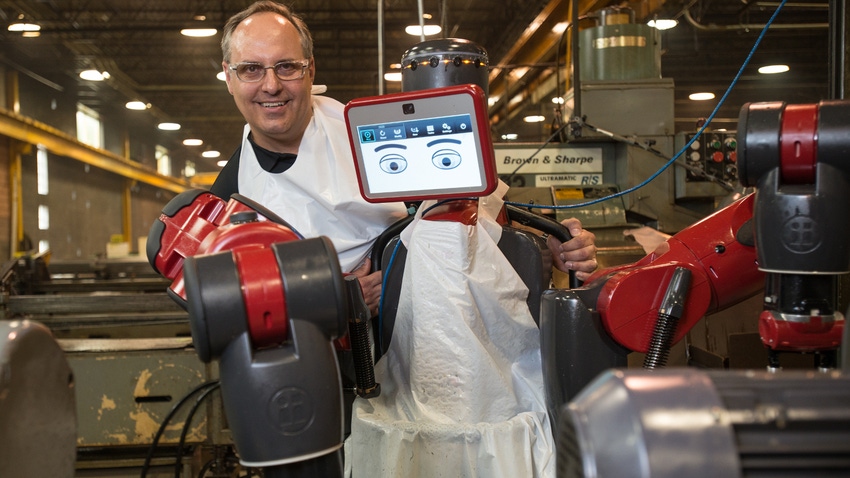Here’s how collaborative robots provide custom automation, cost benefits to manufacturers
February 23, 2016

Manufacturers today strive to be more flexible, nimble and adaptable than ever before to stay competitive. Labor shortages, rising wages and increasing demand for personalized products present challenges to productivity and efficiency. To combat these issues, many manufacturers—including Standby Screw—are turning to flexible automation.
Founded 75 years ago, Standby Screw has, like so many manufacturing companies, shifted from a traditional machine shop to a nimble, innovative organization, bringing the latest technologies to bear. Collaborative robots are an important competitive differentiator that are making factories around the globe more agile and responsive to market demand.
Automation with collaborative robots
Traditionally, customization was an obstacle to automation. As a custom parts manufacturer for outdoor power equipment and automotive industries, Standby Screw knew this precept to be all too true, as the thousands of custom parts we produce required humans to perform mundane, repetitive tasks. From packaging the custom parts into boxes for shipping to cleaning the parts prior to final packing, humans were used for projects that didn’t require them to use cognition or reasoning. Furthermore, there are dozens of other jobs and tasks in our factories that desperately needed people.
Collaborative robots, including Rethink Robotics’ Baxter, which is used on the Standby Screw factory floor, are changing the game when it comes to customization. Baxter is specifically designed to perform in variable, real-world manufacturing environments typical of customized product lines. Because of its Robot Positioning System (RPS), Baxter can easily adjust to parts that are bumped slightly out of place, without the need to stop and reprogram. Further, the robot is so easy to train that any factory worker can conduct the training without any prior programming experience.
At Standby Screw, Baxter works in tandem with a traditional caged industrial robot to clean and package worm shafts, the long, cylindrical gear used in self-propelled, walk behind lawnmowers. A traditional industrial robot from Yaskawa Motoman feeds the parts to Baxter, who then uses both arms to move the parts into a slot and clean the machine oil off the part before placing it into one of two boxes.
Meanwhile, another Baxter robot tends a milling machine by picking pivot rods designed for snow blowers out of a feeding unit and placing them into the machine that cuts a flat end on the rod. In these two instances, the combination of collaborative and industrial robot allows for an efficient, automated process, allowing human workers to focus on tasks that require greater cognitive skill.
True collaboration yields better bottom-line results
Baxter works directly on the factory floor alongside our employees, making it a truly collaborative relationship. As a result of unique force-sensing technology, Baxter is completely safe in this situation. Despite its ability to collaborate with humans, the robots can also be used overnight whenever needed to increase output. With this added production time factored in, Baxter allows our team to package exactly 169 parts per box and produce more than one million parts per year. This high-volume output gives us the freedom to maintain a competitive price point for our products and compete with manufacturers around the globe.
By automating tasks with Baxter at Standby Screw, our employees take on more complex roles throughout the factory, saving the company at least 4,000 hours per year. Baxter allows us to stay nimble and increase consistency in manufacturing operations to better compete on a global stage. We now produce about 1,100 different parts that are used in cars, household appliances and lawn and garden products, and we ship approximately two million parts every week.
Manufacturing has always been complex, but with the many variables present in today’s marketplace, it is more imperative than ever that companies seek the most flexible, cost-effective solutions that enable automation in never before seen applications. Collaborative robots are one piece of the solution that are already bringing results to forward-thinking manufacturers, and this is a trend that will continue to gain momentum for years to come.
Drew Rabkewych, sales manager at Standby Screw, has been with the company nearly 23 years. His favorite thing about working there is the fast-paced environment. “There is never a boring day at the office,” he says. “It is also very fun to see all the finished products that have Standby parts in them.”
___________________________________________________________________________
Poll suggests lack of awareness for cobots in packaging: 60% of those taking our Cobots in Packaging Poll noted that they are unfamiliar with collaborative robots. How about you? It’s not too late to take our quickie poll here.
___________________________________________________________________________
About the Author(s)
You May Also Like


